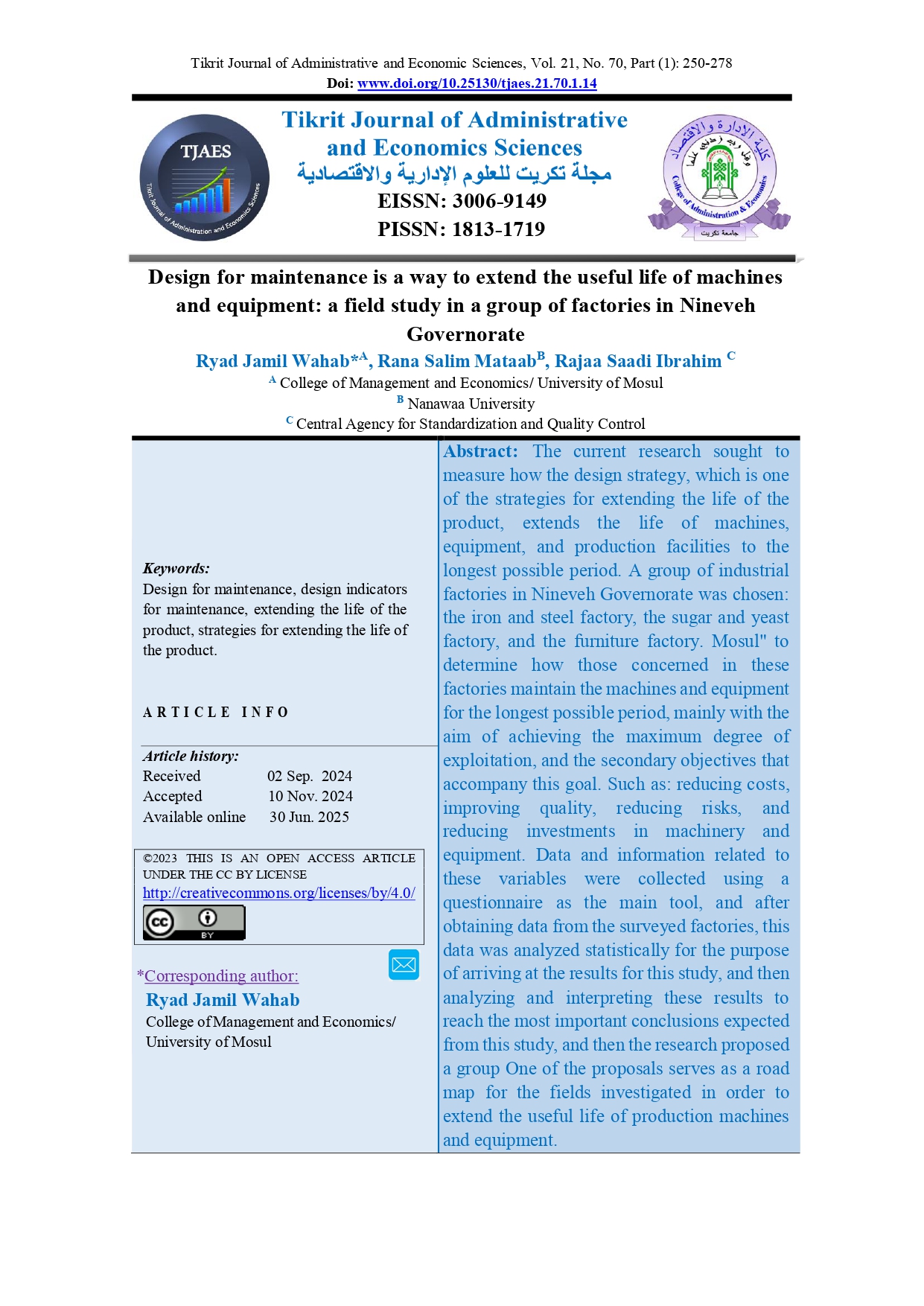Design for maintenance is a way to extend the useful life of machines and equipment: a field study in a group of factories in Nineveh Governorate
Main Article Content
Abstract
The current research sought to measure how the design strategy, which is one of the strategies for extending the life of the product, extends the life of machines, equipment, and production facilities to the longest possible period. A group of industrial factories in Nineveh Governorate was chosen: the iron and steel factory, the sugar and yeast factory, and the furniture factory. Mosul" to determine how those concerned in these factories maintain the machines and equipment for the longest possible period, mainly with the aim of achieving the maximum degree of exploitation, and the secondary objectives that accompany this goal. Such as: reducing costs, improving quality, reducing risks, and reducing investments in machinery and equipment. Data and information related to these variables were collected using a questionnaire as the main tool, and after obtaining data from the surveyed factories, this data was analyzed statistically for the purpose of arriving at the results for this study, and then analyzing and interpreting these results to reach the most important conclusions expected from this study, and then the research proposed a group One of the proposals serves as a road map for the fields investigated in order to extend the useful life of production machines and equipment.
Downloads
Article Details
References
Buinus. M., (2020), Design for maintenance: An interview based survey, master thesis, Malardalen University, School of innovation design & engineering, Sweden.
Mulder. w., Bolk. J., Hoekstra. S., & Kokkeler. F., (2012), Design for maintenance: guidelines to enhance maitaiability, reliability & supportability of industrial products, University of Twenta, Netherlands.
Andrew. Taylor, (2022), Design for maintainability: principles, modularity, & rules, Art & engineering in design products.
Oodee. M., & Owajiony F., (2020), Design for maintainability, Journal of environmental Science & resources management, Vol.12. No.1.
Asmon. A., & Chew. M., (2020), development of a design for maintainability assessment of building systems in the tropic, building & environment, school of design & environment, Singapore.
Anoop.D., & Anil. M., (2006), Design for maintenance: basics concepts & review of literature, international Journal of product development, Vol. 3, No. 1, university of Cincinnati, dept. Of industrial engineering.
Adjonl. O, Benfriha.K., & Aoussat.A., (2020), Design for maintenance: new a algorithmic approach, Journal of Quality in maintenance engineering, Emerald publishing limited.
Dhillon. B., (2004), engineering maintenance: a modern
approach, CRC PRESS, Washington D.C, USA.
Markest. T., & Kumar U., (2003), design & development of product support & maintenance concepts for Industrial systems, Journal of Quality in maintenance engineering, Vol.9, No.4.
Saumava. B., Sanjay. K., & v. Naikan, (2019), A case – based reasoning system for fault detection & Isolation: A case study on complex gearboxes, Journal on quality in maintenance engineering.
Siim. Sild, (2023), design for maintenance principles explained, https://factory.com/design-for-maintenance
Mesa. A., Quiroga. A., Aguiar. M., & Jugend. D., (2022), linking product design & durability: A review & research agenda.
Titu – Marins,(2013), ways to improve the products durability, electro technical, electronica, automatic, Vol.61, No.1.
Durablitiy by design: A guide for residential builder's designers, U.S. department of housing & urban development, office of policy development & research, 2002.
Milios.L., & Dalhammar, (2023), Consumer perceptions of product lifetimes & labeling: implications for introducing a durability label, Journal of circular economy, Vol.1, Issue 1.
Bakker. C., Wang.F., Huisman.h., & Hollander.M., (2014), products that go round: exploring product life extension through design, Journal of Cleaner production,69.
Hollander.M., & Bakker. C., (2013), A business model framework for product life extension.
French Ministry for Ecological & Solidary transition, (2022), Business strategies for extending product lifetime.
Jo. M. F., (2007), Extending product lifetime: prospects & opportunities, European Journal of Marketing, Vol.17, No.4.
Marika. Maata, (2013), Business modes for product lifetime extension, Master thesis in Economic & Business & Administration, Aalto University, School of Business.
Milios.L., (2021), Overarching policy Framework for product life extension in a circular economy – A bottom – Up business perspective, environmental policy & Government Journal, international institute for industrial environmental economics, Lund University, Sweden.
Policy department: Economic & Scientific policy, (2016), a larger lifetime for products, benefits for consumers & companies.
Muztoba. A., Sameer.M., Shaun.W., & Thorstan. W., (2022), Review on upgradability – A product lifetime extension strategy in the context of product service systems, Journal of cleaner production.
Co-funded by the Erasmus + programme of the European Union, (2023), product life extension or up cycling: product life extension for sustainable business.
Linton, J. D. and Jayaraman, V.)2005(. A framework for identifying differences and similarities in the managerial competencies associated with different modes of product life extension. International Journal of Production Research 43(9): 1807-1829.


